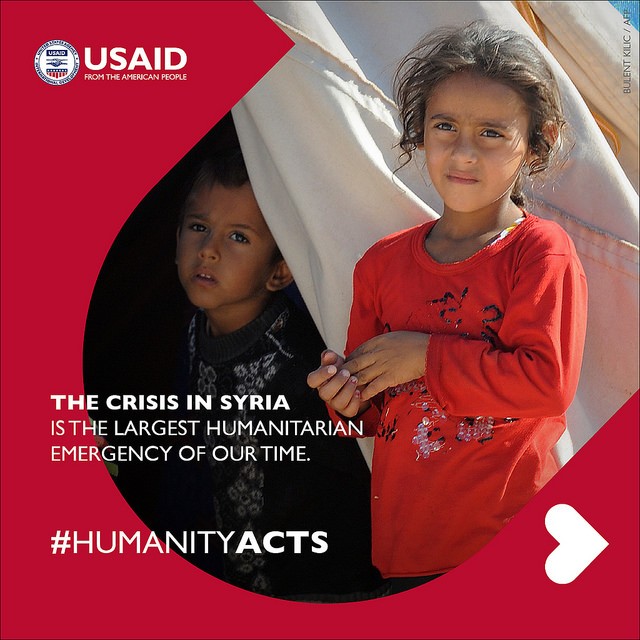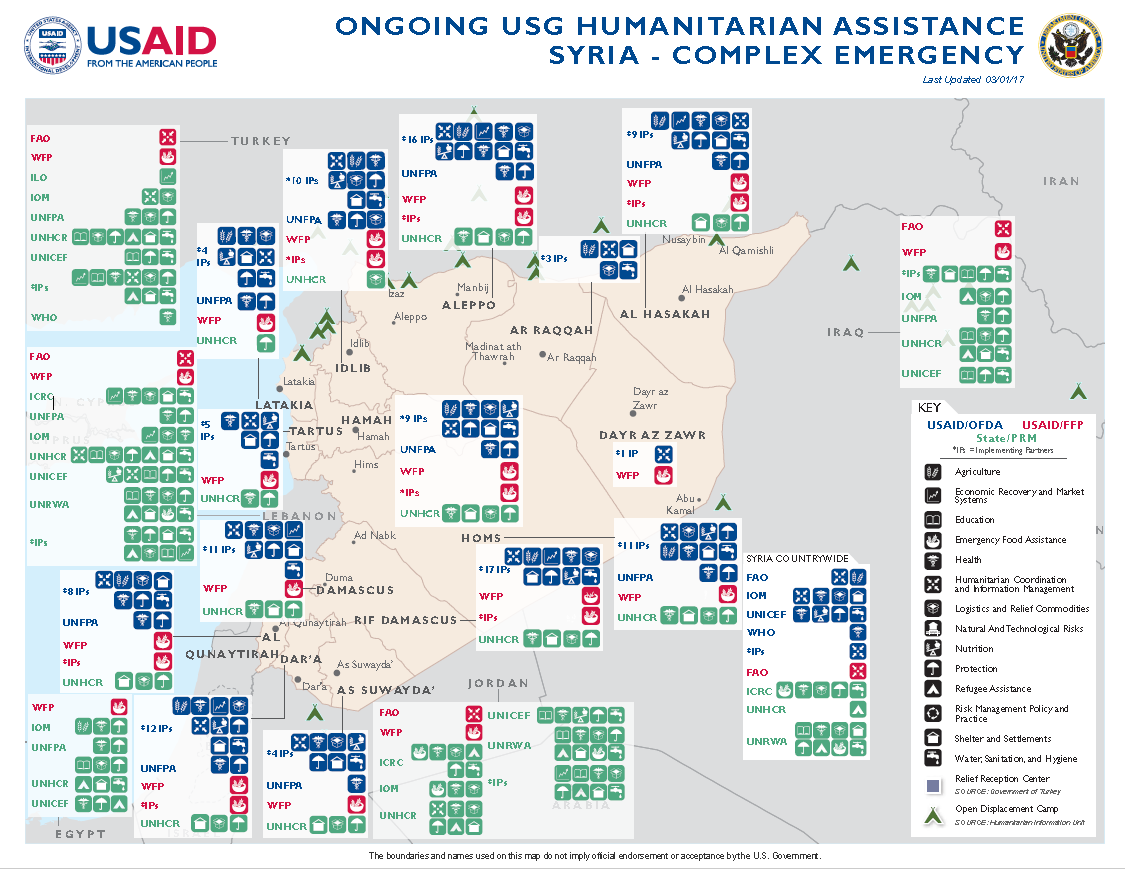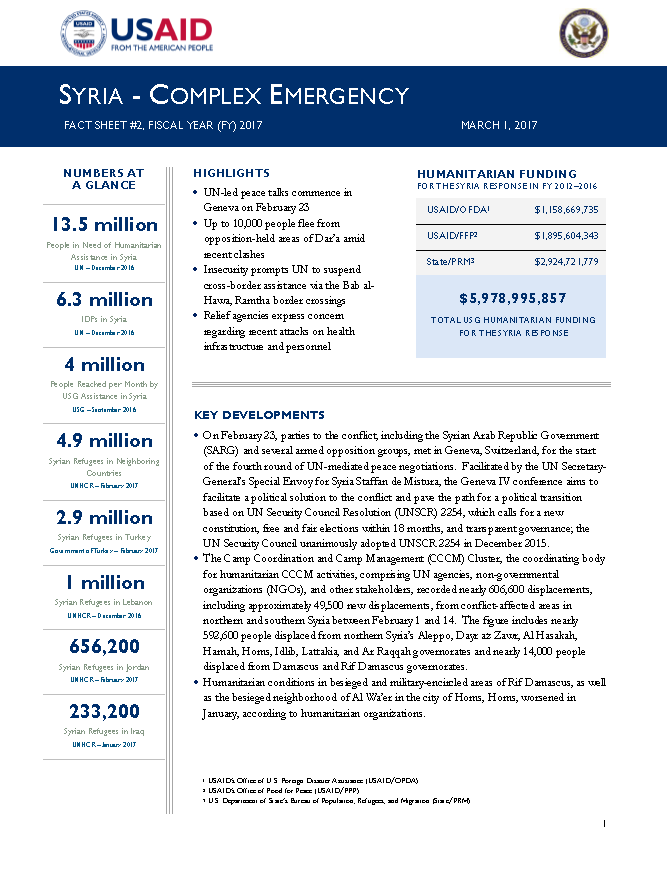- What We Do
- Agriculture and Food Security
- Democracy, Human Rights and Governance
- Economic Growth and Trade
- Education
- Ending Extreme Poverty
- Environment and Global Climate Change
- Gender Equality and Women's Empowerment
- Global Health
- Water and Sanitation
- Working in Crises and Conflict
- Disaster Assistance
- Political Transition Initiatives
- Conflict Mitigation and Prevention
- Countering Violent Extremism
- Disaster Risk Reduction
- Peacebuilding and Reconciliation
- Providing Safe & Secure Environments for Development
- Recovering From Crisis
- Resilience
- Tech Challenge for Atrocity Prevention
- World Humanitarian Day
- U.S. Global Development Lab
March 01, 2017
Highlights
UN-led peace talks commence in Geneva on February 23
Up to 10,000 people flee from opposition-held areas of Dar’a amid recent clashes
Insecurity prompts UN to suspend cross-border assistance via the Bab al-Hawa, Ramtha border crossings
Relief agencies express concern regarding recent attacks on health infrastructure and personnel
Key Developments
On February 23, parties to the conflict, including the Syrian Arab Republic Government (SARG) and several armed opposition groups, met in Geneva, Switzerland, for the start of the fourth round of UN-mediated peace negotiations. Facilitated by the UN Secretary-General’s Special Envoy for Syria Staffan de Mistura, the Geneva IV conference aims to facilitate a political solution to the conflict and pave the path for a political transition based on UN Security Council Resolution (UNSCR) 2254, which calls for a new constitution, free and fair elections within 18 months, and transparent governance; the UN Security Council unanimously adopted UNSCR 2254 in December 2015.
The Camp Coordination and Camp Management (CCCM) Cluster, the coordinating body for humanitarian CCCM activities, comprising UN agencies, non-governmental organizations (NGOs), and other stakeholders, recorded nearly 606,600 displacements, including approximately 49,500 new displacements, from conflict-affected areas in northern and southern Syria between February 1 and 14. The figure includes nearly 592,600 people displaced from northern Syria’s Aleppo, Dayr az Zawr, Al Hasakah, Hamah, Homs, Idlib, Lattakia, and Ar Raqqah governorates and nearly 14,000 people displaced from Damascus and Rif Damascus governorates.
Humanitarian conditions in besieged and military-encircled areas of Rif Damascus, as well as the besieged neighborhood of Al Wa’er in the city of Homs, Homs, worsened in January, according to humanitarian organizations.
Syria Complex Emergency Map #2 - 03-01-2017 ![]() (pdf - 484k)
(pdf - 484k)
Numbers At A Glance
13.5 million
6.3 million
4 million
4.9 million
2.9 million
1 million
656,500
233,200
Humanitarian Funding
To Syria Humanitarian Response
FY 2012 - FY 2016
| USAID/OFDA | $1,158,669,735 |
| USAID/FFP | $1,895,604,343 |
| State/PRM | $2,924,721,779 |
| TOTAL | $5,978,995,857 |
Syria Complex Emergency Fact Sheet #2 - 03-01-2017 ![]() (pdf - 329k)
(pdf - 329k)
2 سوريا حالات الطوارئ المعقدة: صحيفة وقائع رقم ![]() (pdf - 1 MB)
(pdf - 1 MB)
INSECURITY AND POPULATION DISPLACEMENT
Northern Syria
Airstrikes and armed conflict continue to affect civilians throughout northern Syria despite a nationwide ceasefire agreement that commenced on December 30, 2016, according to the UN Office for the Coordination of Humanitarian Affairs (OCHA). On February 7, multiple airstrikes targeted the opposition-held city of Idlib, Idlib, resulting in at least 30 deaths and more than 50 injured people. Additionally, a February 1 airstrike on a Syrian Arab Red Crescent (SARC) office in Idlib city injured several staff and caused extensive damage to the building, international media report.
In Aleppo, military efforts to gain control of the Islamic State of Iraq and Syria (ISIS)-besieged city of Al Bab displaced nearly 37,000 people within Al Bab sub-district to other parts of Aleppo between January 1 and February 21, the CCCM Cluster reports. The majority of displaced people fled to surrounding areas in Al Bab and Azaz districts, while others fled to Aleppo’s Aghtrin and Jarablus sub-districts. As of February 21, an estimated 5,000 civilians remained in Al Bab, according to the UN.
In early November, Syrian Democratic Forces (SDF) launched an offensive to seize control of the ISIS-held city of Ar Raqqah and surrounding areas in Ar Raqqah Governorate. During its first two phases, which spanned early November to February, the Ar Raqqah offensive displaced at least 35,000 people within the governorate and to other parts of northern Syria, according to the CCCM Cluster. Humanitarian organizations anticipate additional population displacement to result from the offensive in the coming months.
In addition to insecurity, ISIS-imposed movement restrictions in Ar Raqqah and an SDF requirement for internally displaced persons (IDPs) to identify a guarantor in their intended place of relocation are influencing displacement trends. IDPs surveyed in Ar Raqqah by the CCCM Cluster in February indicated a preference for localized, temporary displacement to enable their prompt return to areas of origin once conflict subsides. IDPs also reported that family ties, security, and access to humanitarian aid as well as income-generating activities influence their decision of where to seek refuge.
Southern and Central Syria
Intensified fighting, including airstrikes, barrel bombs, and missile attacks, had displaced up to 10,000 people from opposition-controlled areas in Dar’a city, Dar’a, as of February 22, according to the Office of the UN High Commissioner for Refugees (UNHCR). Many displaced people fled to farms and villages southeast of the city.
On February 19, ISIS-affiliated Jaysh Khaled Ibn Waleed forces launched an unexpected offensive, seizing significant territory in southwest Dar’a Governorate, including the towns of Edwan, Jlein, and Tassil, according to Under Secretary-General for Humanitarian Affairs and Emergency Relief Coordinator (ERC) Stephen O’Brien.
Humanitarian conditions continue to deteriorate in besieged and military-encircled areas of Rif Damascus, as well as in the besieged neighborhood of Al Wa’er, humanitarian organizations report. In the Rif Damascus towns of Madaya and Az Zabadani, intensified hostilities and constrained humanitarian access have triggered a critical humanitarian situation, where schools and markets remain closed and access to basic services is minimal.
While SARG authorities have initiated repairs to the damaged Ein al-Fijeh spring in the Wadi Barada area of Rif Damascus, the network is not fully operational; the spring previously supplied safe drinking water for up to 5 million people in Syria’s capital city of Damascus and surrounding areas. As a result, communities near Damascus, such as Barza al-Balad, Jober, Tadamon, Hameh and Qudsyia, and Wadi Barada experienced a further deterioration in access to safe drinking water.
HUMANITARIAN ACCESS
Pursuant to UNSCR 2332, the UN and its humanitarian partners continue to deliver cross-line and cross-border assistance to Syria from Iraq, Jordan, and Turkey. Between January 1 and 31, six UN humanitarian convoys delivered food, health, and water, sanitation, and hygiene (WASH) assistance, as well as other relief commodities for more than 400,000 people via the Ramtha border crossing between Jordan and Syria. Nonetheless, humanitarian access has become increasingly limited in recent months.
Increased clashes in Dar’a, Idlib, and Rif Damascus, as well as other governorates, are hindering humanitarian access and activities. On January 24, the UN suspended cross-border humanitarian assistance via the Bab al-Hawa border crossing between Idlib and Turkey due to increased insecurity, though cross-border operations resumed on January 25. The tense security situation also caused several response agencies to suspend operations in Idlib temporarily during the week of January 23, affecting an estimated 2 million people, according to a statement made by ERC O’Brien on February 22. On February 13, the UN suspended humanitarian convoys traveling from Jordan to southern Syria via the formal Ramtha border crossing due to the insecurity in Dar’a; the suspension remained in place as of February 28.
A UN interagency convoy delivered multi-sector assistance to meet the needs of approximately 107,500 people in the military-encircled town of Ar Rastan in Homs on February 12. The UN last accessed Ar Rastan on November 22, 2016. To date in February, the UN has successfully conducted two interagency convoys to opposition-controlled northern Homs, delivering emergency assistance for nearly 192,000 people, according to the UN. Humanitarian access elsewhere in Syria, including in the besieged towns of Madaya and Az Zabadani as well as Al Fu’ah and Kafraya, Idlib, remains limited. The UN last reached the four towns on November 28. SARG-imposed administrative, operational, and security constraints further impeded humanitarian access in 2016, with only two-thirds of all convoy requests completed throughout the year.
Following two failed attempts to access the besieged neighborhood of Al Wa’er during the week of February 13, active shelling forced a UN convoy carrying assistance for 50,000 people in Al Wa’er to abort its mission on February 20. Upon attempting to return to the warehouse, unidentified assailants diverted several trucks, looting their contents and assaulting some drivers. The last interagency convoy to Al Wa’er occurred on October 26, 2016.
FOOD SECURITY AND NUTRITION
The average price for a standard household food basket—comprising 37 kilograms (kg) of bread, 19 kg of lentils, 19 kg of rice, and 7 kg of vegetable oil—decreased by seven percent between December and January, according to a January vulnerability assessment and mapping exercise conducted by USAID/FFP partner the UN World Food Program (WFP). The cost remains 44 percent higher than in January 2016. Humanitarian access to the formerly besieged eastern Aleppo city and increased food supply in local markets contributed to an 84 percent decrease in food basket costs compared to December. During the same time period, food prices in the ISIS-besieged city of Dayr az Zawr, Dayr az Zawr, increased significantly due to fighting in the area which disrupted markets and humanitarian airdrops to affected populations.
Amid intensified fighting in Dar’a, WFP and its partners provided ready-to-eat food rations for approximately 14,700 IDPs from Dar’a and the nearby Yarmouk Valley. The rations are sufficient to meet the immediate food needs of a five-person household for five days. WFP also provides conflict-affected populations with regular monthly food rations, reaching up to 300,000 people in southern Syria per month. As of February 20, the UN agency had provided 74 percent of targeted households in Dar’a with monthly food rations for February, citing the suspension of humanitarian convoys via the Ramtha border crossing as a key impediment to reaching a greater number of households in need.
HEALTH
Several humanitarian organizations have expressed concern regarding recent attacks on hospitals and other medical infrastructure in Syria. In January, the Turkey-based Health Cluster reported seven unverified attacks on health facilities in Syria, including on one hospital in Aleppo and two hospitals in Rif Damascus; the attacks injured three people.
On February 13, indirect fire struck a hospital in Dar’a, injuring four staff and damaging the hospital’s operating room, warehouse, and several administrative offices. The injured staff were transported to a nearby health facility for treatment. Additionally, on February 15, airstrikes struck six health facilities in Dar’a, causing significant damage and rendering some of the facilities inoperative, according to the UN. Since the beginning of the conflict, the Union of Medical Care and Relief Organizations has documented more than 450 attacks on health structures and more than 750 health worker deaths.
The USAID/OFDA-funded Early Warning Alert and Response Network reported 13 patients with suspected measles in Azaz in January; each of the patients had recently arrived at Shamarekh IDP camp from eastern Aleppo city. Following test results indicating at least 12 positive measles cases, the UN World Health Organization (WHO) launched a 10-day vaccination campaign in Shamarekh. As of February 1, WHO had vaccinated nearly 6,600 children ages six months to 15 years.
REFUGEE ASSISTANCE
As of February 16, U.S. Government (USG) partner UNHCR had registered more than 4.9 million Syrian refugees in neighboring countries, including Egypt, Iraq, Jordan, Lebanon, and Turkey, as well as parts of northern Africa. Turkey remains the largest host nation, with more than 2.9 million Syrian refugees registered in the country as of mid-February.
In January, the UN Children’s Fund (UNICEF) reached nearly 7,200 children with psychosocial support through child and adolescent friendly spaces in refugee camps and host communities in Turkey. Additionally, more than 26,900 migrants and refuges received multidisciplinary services, including counselling, through five UNICEF-supported centers. UNICEF and its partners also provided nearly 10,600 Syrian refugee households and Turkish host community members with cash-based assistance to help meet basic needs during the winter season.
On February 16, USG partner the UN Relief and Works Agency for Palestine Refugees in the Near East (UNRWA) completed its fifth distribution cycle in Syria for 2016. The two-month cycle, which began on December 3, reached approximately 400,000 Palestinian refugees in 15 locations across Syria. Each household received a food basket, comprising cooking oil, halawa, lentils, pasta, powdered milk, rice, and sugar, and covering 700 kilo calories per person per day—a third of the daily caloric needs recommended by the WFP. UNRWA also distributed nearly 3,430 hygiene kits to Palestinian refugees in Aleppo and Dar’a.
USAID/FFP partner WFP continued to reach more than 1.6 million Syrian refugees in Egypt, Iraq, Jordan, Lebanon, and Turkey in February with food vouchers, issued on debit cards. The food voucher program enables vulnerable people, including women-led households, to access local supermarkets, thereby helping to restore their dignity. The program also supports local economies by ensuring food supplies are purchased locally. To date, the program has issued $1.7 billion in food vouchers.
OTHER HUMANITARIAN ASSISTANCE
On February 20, the Government of the Czech Republic (GoCR) provided the SARC nearly four metric tons of powdered milk for onward distribution to displaced populations; the GoCR dispatched a second batch of powdered milk and toys, collected via private donations, on February 23. To date, the GoCR has contributed 7.6 million Czech Crowns—nearly $300,000—in in-kind relief commodities for conflict-affected people as part of an ongoing effort to provide development, humanitarian, and reconstruction aid to Syria. Additionally, the GoCR is providing educational support, food and shelter assistance, and medical care to conflict-affected populations in Syria and neighboring countries. In 2016, the GoCR reports contributing more than 200 million Czech Crowns—approximately $7.8 million—for these activities.
CONTEXT
Following the commencement of peaceful demonstrations against the SARG in March 2011, President Bashar al-Asad pledged legislative reforms. However, reforms failed to materialize, and SARG forces loyal to President al-Asad began responding to demonstrations with violence, leading armed opposition groups to retaliate.
At a November 2012 meeting in Doha, Qatar, Syrian opposition factions formed an umbrella organization—the National Coalition for Syrian Revolutionary and Opposition Forces, also known as the Syrian Coalition (SC). The USG recognized the coalition as the legitimate representative of the Syrian people on December 11, 2012. On March 19, 2013, the SC established the Syrian Interim Government, which opposes the SARG and is based in decentralized locations throughout opposition-held areas of Syria.
On July 14, 2014, the UN Security Council adopted UNSCR 2165, authorizing UN cross-border and cross-line delivery of humanitarian aid to conflict-affected populations without SARG approval. The resolution permits the UN’s use of four border crossings from Turkey, Jordan, and Iraq—in addition to other crossings already in use by UN agencies—for delivery of humanitarian assistance into Syria. The resolution also establishes a monitoring mechanism under the authority of UN Secretary-General Ban Ki-moon and with the consent of the neighboring countries to ensure that deliveries across these border points contain only humanitarian items. The UNSC has subsequently adopted several resolutions renewing the mandate of UNSCR 2165, most recently in December 2016 with the adoption of UNSCR 2332, extending the authorities granted until January 2018.
Prior to the start of the conflict, UNRWA had registered approximately 560,000 Palestinian refugees in Syria, with more than 80 percent living in and around Damascus. Intense fighting in and around some Palestinian camps and neighborhoods has significantly affected Palestinian refugees in Syria. UNRWA estimates that approximately 60 percent of Palestinian refugees are displaced within Syria, with a further 110,000 Palestinian refugees displaced to neighboring countries. Syria also hosts an estimated 24,000 Iraqi refugees and asylum seekers, primarily in the greater Damascus area, as well as more than 3,200 refugee persons of concern from other countries.
PUBLIC DONATION INFORMATION
The most effective way people can assist relief efforts is by making cash contributions to humanitarian organizations that are conducting relief operations. A list of humanitarian organizations that are accepting cash donations for disaster responses around the world can be found at www.usaid.gov/crisis/syria.
The USG encourages cash donations because they allow aid professionals to procure the exact items needed (often in the affected region); reduce the burden on scarce resources (such as transportation routes, staff time, and warehouse space); can be transferred very quickly and without transportation costs; support the economy of the disaster-stricken region; and ensure culturally, dietary, and environmentally appropriate assistance.










Comment
Make a general inquiry or suggest an improvement.